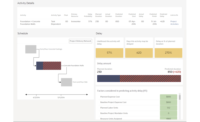Artificial Intelligence
AI-based Tool Optimizes Construction Schedules Straight From P6
ALICE Technologies schedule optimizer no longer requires a full BIM

ALICE Technologies' artificial intelligence-backed scheduler no longer requires a full building information model and can optimize construction activities directly from an Oracle Primavera P6 file. Screenshot courtesy of ALICE Technologies.
Unearthing the insights to improve a construction schedule and solve problems before they happen is no small task, but a new artificial intelligence-based tool from ALICE Technologies is able to optimize schedules directly from an Oracle Primavera P6 file.
In construction scheduling, keeping track of the countless variables at work in complex projects can make the process seem more like an art than a science. Finding a better path through that project delivery wilderness was the original goal of ALICE when it first introduced its artificial intelligence-based schedule optimizer in 2017.
This system used an element-based analysis of construction schedules to take into account every piece of a project’s building information model and what it would take to build it, down to the work crews, material deliveries and site access required. The algorithms that underlie the system work from a series of “recipes” for what it takes to build various construction elements: floors, columns, etc. The system then simulates construction of the building based on the BIM data, taking into account what is required to complete the various tasks and how they must be sequenced.
This initial version of ALICE has come a long way in the intervening years, and has been used on hundreds of projects, from vertical construction to large, complex oil and gas facilities. But despite the advantages in scheduling that ALICE offers, it has been limited so far by the requirement for a detailed BIM to ingest, says Rene Morkos, ALICE founder.
“We went back to the drawing board,” he says. “Clients loved our product, take a BIM and run simulations of it, but they were always asking: ‘Can you do this from a P6 schedule?’”
As the ALICE system has improved from the many projects it has been used on, Morkos says they are confident it can work directly off the schedule. The existing BIM-derived ALICE product will become ALICE Pro, while the new P6-derived product will be known as ALICE Core.
“For the first time, we’re speaking the same language as the schedulers and GCs are using,” Morkos says.
The company is partnering with Oracle to ensure the import/export process for Primavera P6 is relatively seamless, and Morkos hopes that this new approach will bring the benefits of an AI schedule optimizer to users who were not interested in building out full BIMs of their projects.
“The aspiration is to bring this construction optioneering to a much wider audience, no longer dependent on BIM,” explains Phil Carpenter, chief marketing officer at ALICE. He adds that in addition to opening it up to customers in the U.S. who have been slow to shift to BIM-based project delivery, it also allows ALICE to bring improvements to smaller projects that typically don’t usually warrant creating highly detailed BIMs.
The process for using ALICE Core essentially has two steps. First there is the assessment phase, where the system digests the XCR file from P6 and presents it in a coherent sequence with all the variables labeled and linked. Labor, materials and other factors are extrapolated from P6 and presented in a visual representation of the schedule. The process takes only a few minutes, and allows schedulers to examine their project in full, with all of the dependencies and variables represented with arrows and markups.
The next step, which takes a little more time for the AI-based system to churn, is the recover phase, where the ALICE system re-sequences and shuffles tasks and other schedule elements around to see if it can save time, money or meet other user-defined constraints. These can involve the user tweaking small changes to see how they would affect project cost or time, or just setting fixed constraints on cost, time, labor or equipment and sitting back while ALICE reshuffles everything to meet those requirements.
“The thing about ALICE is it will never let you produce a schedule that violates the constraints you set,” explains Shane Richardson, president of LaGrange Consulting, who advises large project owners and general contractors on their cost and scheduling issues. “And anyone can do this with ALICE, pull it in and see the issues with the project.” Richardson says just the initial step of visualizing the P6 schedule has been helpful for several of his clients working on large industrial projects.
Richardson says the ability to set constraints as specific as site conditions, regulatory goals, specific project milestones, equipment availability, crew sizes and other factors lets a new user start tweaking a project schedule in significant ways after only a few minutes of training.
“ALICE is a pretty different way of scheduling, but I think it’s the future way of doing things—they are way ahead of the curve, and it’s hard for companies to step fully into ALICE,” says Richardson. “This new integration with P6 is the stepping stone to import their schedule and see possible improvements right away.”
Any file generated in ALICE Core can then be exported back into Primavera P6, allowing for schedulers to get back to work with their new optimized workflow, says Carpenter. “It really helps democratize what we have done previously,” he says.
Morkos adds that his team enjoyed getting their sophisticated AI-based system to a point where anyone running a project can enjoy its benefits. “Previously we had built an F-16 [fighter jet], but now we have built a Ford F-150 with an F-16 engine in it.”




